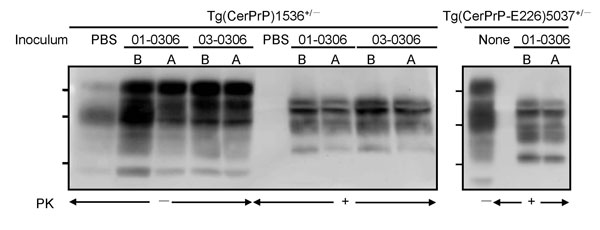Volume 15, Number 5—May 2009
Research
Chronic Wasting Disease Prions in Elk Antler Velvet
Figure 2

Figure 2. Accumulation of PrPSc (disease-associated form of prion protein) in diseased transgenic (Tg) mice. Tg(CerPrP)1536+/– and Tg(CerPrPE226)5037+/– mice inoculated with phosphate-buffered saline (PBS), elk brain (B), or antler velvet (A) were treated with or without proteinase K (PK). Membranes were probed with monoclonal antibody 6H4. Molecular weights indicated are 37, 29, and 20 kD.
Page created: December 16, 2010
Page updated: December 16, 2010
Page reviewed: December 16, 2010
The conclusions, findings, and opinions expressed by authors contributing to this journal do not necessarily reflect the official position of the U.S. Department of Health and Human Services, the Public Health Service, the Centers for Disease Control and Prevention, or the authors' affiliated institutions. Use of trade names is for identification only and does not imply endorsement by any of the groups named above.